Land Rover series 2 2A 3 Workshop Repair Manual
The land-rover Series we, II, and III is off-road vehicles from the Uk maker Land Rover which were impressed because of the US-built Willys Jeep.
Show brands showcase leaf-sprung suspension system with selectable two or four-wheel drive; although Stage 1 V8
Land Rover Series II and IIA Specification Guide
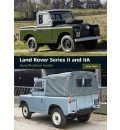
Land Rover Series II and IIA Specification Guide by James TaylorGet other Land Rover repair manuals hereThe Series II [1958-61] and Series IIA [1961-71] Land Rovers defined the iconic shape of the vehicle which is still instantly recognizable in today s utility models from Land Rover. Compiled over nearly thirty years with the aid of reference material produced by Land Rover and many dedicated enthusiasts this comprehensive guide to the specifications of the Series II and IIA vehicles looks not only at Land Rovers as they were when they left the assembly lines but also at dozens of options and approved special conversions - and some which did not receive factory approval too.Land Rover Series II and IIA Specification Guide by James Taylor
Land Rover Series II,IIA,III repair manual 1958-1985
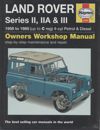
Land Rover Series 2 2A and 3 1958 to 1985 Petrol and Diesel Haynes Service and Repair Manual NEW hardback 150 pages Other Land Rover Service and Repair Manuals click here Land Rover Series 2 2A 3 Petrol 1958 - 1985 Haynes Owners Service Repair Manual Covers: Series 2 2A and 3 (Including County) with 88 and 109-inch wheelbase 1958 - 1985. 2 1/4 litre (2286cc) 4 Cylinder Petrol.2.25 litra (2286) 4-cylinder Diesel Does NOT cover 6 Cylinder or V8 engines. 24V electrical systems or forward control models.Inside this manual you will find: Routine Maintenance tune-up procedures engine repair cooling and heating air-conditioning fuel and exhaust emissions control ignition brakes suspension and steering electrical systems and wiring diagrams.
Land Rover Series I, II and III Restoration Manual
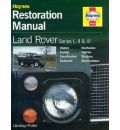
Land Rover Series I II and III Restoration Manual by Lindsay PorterGet other Land Rover repair manuals hereThe Land-Rover was the first British four-wheel-drive vehicle of its type. Having enjoyed world-wide success with numerous models variants and modifications this book takes the reader through the acquisition and restoration of a typical Land-Rover with detailed descriptions and illustrations of the processes needed to thoroughly renovate and improve the vehicle. The book includes tips on what to look for when buying this type of vehicle how to renovate bodywork and chassis how to strip out and replace interiors and how to overhaul engine electrical components and suspension systems. Integracar tries to provide you with a diverse diversity of service guides. But yet owners manuals could well be released for multiple countries and the automobiles built for those countries. So not all maintenance manuals may be best for your selected automobile. If you have any quer
Land Rover Series 2 2A 3 1959 1983 Service Repair Manual Brooklands Books Ltd UK
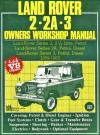
Get other Land Rover repair manuals hereRe-issue of Autobooks manual covering all tasks and components for the following: Series 2 2.25 litre Petrol 1959 - 1961. Series 2A Petrol and Diesel 1961 - 1971. Series 3 Petrol and Diesel 1971 - 1983.Land Rover Series 2/2A/3 1959 - 1983 Manual Covers all 4 6 and V8 engines 1959 - 1983Contents: The Petrol Engine. The Diesel Engine. The Petrol Fuel System - Solex Zenith Stromberg and SU Carburetters (Carburettors). The Diesel Fuel System. The Ignition System. The Cooling System. The Clutch. The Gearbox and Transfer Gearbox. Propeller Shaft Rear Axle and Rear Suspension. Front Suspension Differential and Hubs. The Steering Gear. The Braking System. The Electrical Equipment. The Bodywork. Optional Equipment. Technical Data. Wiring Diagram 2.25 Litre Petrol Models Series 2 - Positive Earth. Wiring Diagram 2.25 Litre Petrol Models Series 2A Positive Earth. Wiring Diagram 2.25 Litre Diesel Models Series 2A Positive
Land Rover Series 2 2A Petrol Diesel Repair Operation Manual Brooklands Books Ltd UK
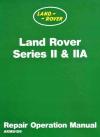
Get other Land Rover repair manuals hereLand Rover Series 2 2A Repair Operation Manual previously issued in separate parts now combined in one comprehensive manual.Covers All Series 2 2A 2.25 litre 2.6 litre Petrol and 2.25 litre Diesel Engines - Clutch - Gearbox - Transfer BoxContents: Engine - 2.25 litre 4 Cylinder Petrol. Engine - 2.25 litre 4 Cylinder Diesel. Engine - 2.6 Litre 6 Cylinder Petrol. Clutch Units. Gearbox. Propellor Shafts. Rear Axle Suspension. Front Axle Suspension. Steering Linkage. Brake System. Chassis. Cooling System. Fuel System. Exhaust System. Electrical Equipment. Circuit Diagram 2.25 Litre Petrol Models Series 2 Positive Earth Circuit Diagram 2.25 Litre Petrol Models Series 2A Positive Earth Circuit Diagram 2.25 Diesel Models Series 2A Positive Earth Circuit Diagram Regular and Long Diesel Models Series 2A with combined electrical services starter and heater plug switch positive Earth Circuit
Land Rover Series IIA and IIB Instruction Manual
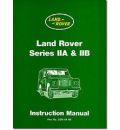
Land Rover Series IIA and IIB Instruction Manual by Brooklands Books LtdGet other Land Rover repair manuals hereCovers long and short wheelbase and forward control models. A4 format.
Show brands showcase leaf-sprung suspension system with selectable two or four-wheel drive; although Stage 1 V8 type of the Show III showcased permanent 4WD. All three versions could be going with a front hand crank along with a choice of a rear power takeoff for add-ons.
In another building, I gazed in wonderment in the incredible energy of a machine that stamped the huge aluminum human body sections of the then-new number Rover. And then I entered a hall where Defender manufacturing happened.
Old land roversIt was like an occasion warp. Instead of frantic robots melding huge and complex equipment when you look at the blink of an eye fixed, there were blokes in green overalls wielding spanners and rivet guns, carefully and systematically putting motors together manually. As a result, the Defender production range ran at a far slower speed than that the greater modern Land Rovers rolling out of the building next-door.
This out-of-date manufacturing technology is amongst the explanations why, after an incredible 67 ages, Defender manufacturing is coming to a conclusion. Yes, another explanation is the fact that Land Rover happens to be not able to modernise current Defender build to meet up with existing and future security and emission specifications, but the labour-intensive production range is certainly a powerful factor.
1947: at first
Until you├ó┬Ć┬Öve been hiding under a stone, you├ó┬Ć┬Öd have heard the storyline about Rover├ó┬Ć┬Ös then-technical main Maurice Wilks sketching the initial land-rover in 1947 on the sands of Red Wharf Bay on his farm at Newborough, Anglesey, Wales.
He was prompted, supposedly by a question posed by his sibling Spencer, then-managing director of Rover, just who asked Maurice exactly what he'd do whenever their old army surplus Jeep wore out.
Land rover in beginningThe set after that became intention on creating a multi-purpose, go-anywhere car that Rover could export to improve the organization├ó┬Ć┬Ös post-war production. Ironically, a Jeep chassis ended up being put beneath the first model.
That prototype featured a centre-mounted tyre and ended up being coated in military-surplus cockpit paint, of which there was lots after WWII.
By the time the car was revealed at Amsterdam Motor program in 1948, the centre-steering had been flicked towards an even more standard setup. The Land Rover show I showcased a unique unique box-section galvanised steel framework on which ended up being mounted a very simple sheet-aluminium system ├ó┬Ć┬ō steel ended up being tricky to find but aluminum had been plentiful as plane manufacturing wound down following the war.
Early land roverThe system ended up being Rover├ó┬Ć┬Ös established pre-war design 1.6-litre four-cylinder petrol unit with overhead inlet and part exhaust valves, mated to a four-speed gearbox and a two-speed transfer situation, and a permanent four-wheel drive program.
Contributing to the vehicle├ó┬Ć┬Ös versatility, power take-offs are suited to allow the Land Rover to be utilized as a stationary power device, and very early marketing and advertising brochures often showed different pieces of farming gear connected to the automobile.
The ease of use and robustness associated with Series we proved hugely popular, utilizing the Land Rover going on to become a Brit production achievements facts that far exceeded initial objectives. In the 1st season of manufacturing, just 3048 Land Rovers are built, but that rose to 8000 in 1949 and also by 1950 that jumped to 16,000.
Land-rover beginning in waterOver the following couple of years the land-rover slowly evolved; the permanent four-wheel drive is changed in 1950 with a method that let drivers to pick two or four-wheel drive-in large number. The Series II ended up being launched in 1958, followed closely by the show IIA in 1961 together with Series III in 1971. By this time, the system options included 2.25-litre petrol and diesel fours, while some later, a 2.6-litre petrol six is introduced.
By 1976, one million Land Rovers have been created and also the automobile was now dramatically improved through the earliest build, with two wheelbase alternatives and a giant number of human body alternatives. However the essence associated with first land-rover ended up being nevertheless demonstrably noticeable into the vehicle├ó┬Ć┬Ös build and underpinnings.
The successor towards the effective show I became the show II, which saw a manufacturing run from 1958 to 1961. They arrived in 88 in and 109 in wheelbases. This is the very first Land Rover to get the eye of Rover's styling division- Chief Stylist David Bache created the familiar 'barrel part' waistline to pay for the vehicle's broader track and the improved build associated with the truck taxi variation, presenting the curved side house windows and rounded roof still applied to existing Land Rovers. The show II was the initial vehicle to use the popular 2.25-litre petrol motor, even though the first 1,500 or so quick wheelbase systems retained the 52 hp 2.0-litre petrol engine from show we. This bigger petrol system produced 72 hp and is closely pertaining to the 2.0-litre diesel product however used. This engine became the standard Land Rover product before the mid-1980s when diesel motors became more popular.
The 109-inch show II place Wagon launched a twelve-seater alternative together with the conventional ten-seater design. It was primarily to benefit from UK taxation laws, in which an automobile with 12 seats or higher was classed as a bus, and is exempt from Purchase income tax and Special automobile Tax. This made the twelve-seater not only economical purchasing versus 10-seater variation, additionally less expensive than the seven-seater 88-inch place truck. The twelve-seater design stayed a highly popular body design for many years, being retained from the subsequent Series and Defender variants until 2002, when it is fallen. The strange standing regarding the twelve-seater stayed until the end├ó┬Ć┬ösuch vehicles are classified as minibuses and thus could use bus lanes and may feel exempt from the London obstruction Charge.
There clearly was a point of over-lap between Series I and show II manufacturing. Early Series II 88-inch motors were fitted using older 2-litre petrol engine to use up established stock from production of the Series I 107-inch section Wagon proceeded until belated 1959 because continued demand from export areas also to let the creation of Series II equipment to reach complete level.
The SII together with SIIA have become difficult to differentiate. There were some lesser aesthetic changes, although most critical modification is beneath the bonnet when you look at the guise of this brand-new 2.25-litre diesel system. Human anatomy designs offered by the factory ranged from short-wheelbase soft-top to your top-of-the-line five-door section truck. In 1967 a 2.6-litre inline six-cylinder petrol system was introduced for the long-wheelbase systems, which had servo-assisted brakes. 811 of the were NADA trucks, which were the only long-wheelbase brands created for the United states and Canadian areas.
From February 1969, the headlamps relocated into the wings on all brands, in addition to sill panels were redesigned to-be shallower a couple of months a short while later.
The show IIA is known as by many more sturdy show design built. Additionally it is the sort of classic Land Rover that has highly in the general public's perception of the Land Rover, from the numerous appearances in preferred films and television documentaries emerge Africa for the 1960s, eg Born totally free. In February 1968, just a couple period as a result of its manufacturer have been subsumed, under authorities force, into the Leyland Motor organization, the land-rover celebrated its twentieth birthday, with complete production currently only short of 600,000, that more than 70% was in fact shipped. Definitely it absolutely was as the Series IIA was in production that sales of energy Land Rovers achieved their peak, in 1969├ó┬Ć┬ō70, whenever sales of over 60,000 Land Rovers a year were recorded. Plus record purchases, the land-rover dominated most world markets- in Australian Continent in 1960s land-rover held 90per cent of 4├ā┬Ś4 markets. This figure ended up being repeated in many region in Africa and center East.
The Series III had exactly the same human anatomy and engine choices while the preceding IIa, including section wagons as well as the 1 great deal variations. Minimal changed cosmetically from the IIA towards Series III. The show III is considered the most typical show car, with 440,000 regarding the type built from 1971 to 1985. The headlights had been relocated to the wings on belated production IIA models from 1968/9 onward and stayed in this position when it comes to show III. The standard material grille, featured from the show we, II and IIA, was changed with a plastic people for the Series III design. The 2.25-litre system have their compression increased from 7:1 to 8:1, enhancing the power a little. During show III manufacturing run from 1971 until 1985, the 1,000,000th Land Rover rolled from the production line in 1976. The show III saw many changes in the later section of their life as land-rover updated the design to generally meet increasing competitors. It was 1st design to showcase synchromesh on all four gears, though some late H-suffix SIIA versions had used the all-synchro field. Commensurate with early 1970s styles in automotive interior decorating, in both protection and employ of more advanced products, the simple material dashboard of prior versions is redesigned to simply accept a unique moulded vinyl dash. The instrument group, that has been formerly centrally located, was moved to the driver's part. Long-wheelbase Series III motors had the Salisbury rear axle as standard, though some belated SIIA 109-inch automobiles had them too.
In 1980, the 2.25-litre petrol and diesel machines gotten five primary bearing crankshafts to improve rigidity while the transmission, axles and wheel hubs are strengthened. This is the culmination of a number of updates towards transmission that were made considering that the sixties to combat the all-too-common issue of the trunk axle half-shafts breaking in heavy use. This problem had been partially because of the design of shafts on their own. As a result of fully floating build regarding the backside wheel hubs, the 1 / 2 shafts can be removed quickly without even having to jack the car from the crushed. The propensity for commercial operators to overload their automobiles exacerbated this flaw which blighted the Series Land Rovers in several of these export areas and established a reputation that continues in lots of areas to the present day. This is certainly despite the 1982 re-design that every but fixed the problem.
In addition, newer trim options had been introduced to make the inside convenient if the customer so wished.
These changes culminated in April 1982 utilizing the introduction regarding the "County" spec. Place Wagon Land Rovers, available in both 88-inch and 109-inch types. These have all-new cloth chairs from the Leyland T-45 Lorry, soundproofing kits, shaded glass as well as other "soft" alternatives built to attract the leisure owner/user.
Of more interest ended up being the introduction of the extreme Capacity get into 109-inch framework. This is a pick-up truck load bay that supplied 25per cent most cubic capacity compared to standard pick-up style. The HCPU was included with heavy-duty suspension and ended up being well-liked by public utility organizations and building contractors.
Australian continent has become a significant export market for Land Rovers of varied brands, but particularly the energy versions. 80-inch show we designs were offered into the Australian government in late 1940s for run civil engineering projects including dams and roadway building, which brought the vehicle into buying public's focus. Big sales accompanied and in the 1950s Land Rover established production facilities in Australian Continent to create CKD kits delivered from the Solihull factory. The Land Rover continued to sell better throughout the 1960s in Series II guise, commanding some 90per cent of this off road markets, and with practically every farm creating one Land Rover.
The show III carried on this triumph in the early 1970s, but through the middle of this ten years business declined. A sizable coal export package to Japan relied from the subsequent import of Japanese cars and other goods, a variety of this increasing competition and more and more low quality associated with components being shipped from Britain meant that land-rover's prominence slipped. A problem specific to Australia ended up being the always-limited method of getting newer Land Rovers. Leyland's factory never had the capability to satisfy feasible demand additionally the need certainly to import very nearly the entire automobile in system kind from Britain limited the provide and manufacturing techniques further. This generated a long waiting list developing for the Leyland product whilst commercial operators could see large fleets of Japanese motors very quickly. Others dilemmas faced by-land Rover are the same throughout their export areas- compared to the Japanese competitors, the Land Rover was underpowered, unreliable and sluggish with an unhealthy ride high quality, despite their better off road potential. Bad rust-proofing and low-quality metal found in comparison towards the Japanese cars turned the purchasers away in large numbers by 1983, because of the introduction associated with the One Ten, the Toyota Land Cruiser became the best-selling 4├ā┬Ś4 in Australia.
During the early 1980s, land-rover Australia have made some changes toward automobile to try to fight this business drop. Plus the fitting of the V8 petrol engine in the 1979 "level One", such as the remainder globe, Australia in addition received exactly the same vehicle using solution of a 3.9-litre 97 hp four-cylinder Isuzu diesel engine. This was launched in 1982, and ended up being supposed to be equipped in about 10 % of the Australian manufacturing. Top speeds is 77 miles per hour. This assisted slow the purchases decline, although rest of the vehicle's shortcomings let it straight down. Usually the one Ten was also readily available with this specific motor, and a turbocharged variation making in excess of 100 horsepower operated the armed forces 6├ā┬Ś6.
Land Rover Series III Pickup
Short wheelbase Land-rover Show III
South Africa
South Africa's commitment with Land Rover were only available in 1949 when the very first Series we 80-inch products had been sold in South Africa. In August 1950, vehicles vendors set up Ltd put together the initial Land Rover CKD in slot Elizabeth, South Africa. Initial regional production of gasoline tanks and framework on Port Elizabeth plant ended up being established in August 1963 and after that the local content inside creation of Land Rovers increasing steadily to 44% of automobile fat by 1972. Regional content included: framework, roadway springs, physique, tyres, seat frames and upholstery, battery, fibreglass roofing and all glass. In 1974 Leyland SA had 3 assembly herbs. Regional content increasing more in 1980 using show IIIS brands fitted with in your area created petrol and diesel machines. In 1992 the Blackheath factory within the Cape Province is recognized as the biggest Land Rover CKD assembly outside of the UK.
The British Army made use of Series Land Rovers in large numbers. The British military tested the 80-inch show I land-rover practically as soon as it was established in 1948. During Those Times, the Army ended up being keen on developing a specially designed armed forces utility 4├ā┬Ś4. But the Champ shown also complex, heavier and unreliable in battlefield conditions and so the military searched on land-rover. Within the belated 1940s the Ministry of Defence was thinking about the standardisation of its automobiles and equipment. Section of this course of action was to compliment Rolls-Royce petrol motors to all their vehicles. A batch of Series I Land Rovers are fitted with Rolls-Royce B40 four-cylinder engine, which required adjustment to an 81-inch wheelbase). However, the motor is too heavy and slow-revving, which stunted results and created torque that the Rover gearbox could recently handle. Rover persuaded the MOD that, thinking about the degrees of Land Rovers they were thinking about ordering, that the standard 1.6-litre motor would suffice. The MOD going ordering Land Rovers in batches from belated 1949. The initial batches are for 50 vehicles, but because of the mid-1950s the Army is purchasing Land Rovers 200 cars at a time.
Land Rovers had been implemented towards Korean War additionally the Suez Crisis, and became standard light army automobiles through the Commonwealth.
However, since the 1960s progressed, more specialised variations had been created. Plus the standard 'GS' motors, a common variation was the 'FFR' Series II and Series III chassis. A well-known version had been the LRDPV, commonly known as the 'Pink Panther', due to their distinctive light red sand camouflage. These 109-inch Series IIs had been removed side and windscreens and fitted with grenade launchers, a machine firearm installing band and long-range gas tanks and water tanks. These were utilized by the SAS for wilderness patrol and unique functions.
1983 Series III HT Lightweight
By the belated 1970s, the British Army have obtained around 9,000 Series III brands, which were primarily a special 'Heavy Duty' form of the 109-inch smooth Top. These models had enhanced suspension equipment and yet another chassis cross-member design. We were holding produced in 12-volt 'GS' brands and 24-volt 'FFR' variations. A tiny number are 88-inch GS and FFR products, however in basic the Army used the Air-Portable 1/2 ton, 88-inch "light" version. The light was at solution by many people armies all over the world. In Europe even the Dutch Landmacht in addition to Danish military put the Land-Rover Lightweight. Instead of the petrol engine the Dutch and Danish Lightweights have diesel motors. As opposed to the fabric top the Dutch ones have PVC tops like contemporary land-rover 'Wolf'.
Additionally, there have been also 101-inch forwards controls brands, 109-inch FV18067 ambulances built by Marshall Aerospace of Cambridge.
The Royal Navy and Royal atmosphere energy furthermore acquired and maintained modest Land Rover fleets through the sixties and 1970s. The RAF utilized 88-inch brands for communications, liaison, personnel transport and airfield tractor responsibilities. The Royal Navy's fleet had been, understandably, tiny and consisted primarily of GS-spec and place truck versions for employees and cargo transportation.
All British military Land Rovers made use of the 2.25-litre four-cylinder petrol engine. But some overseas customers specified the 2.25-litre diesel device rather.
The Land Rover is also the foundation for Shorland Internal Security Patrol automobile developed by Short Brothers.
Australian Continent
Australian military Land Rover sets 2 anti-tank "gunbuggy" with a 106mm recoilless rifle.
Australian military Land Rover implemented to Namibia during UNTAG on display on Australian War Memorial.
The Australian-made series 1, 2, 2A and 3 were trusted because of the Australian military, Royal Australian Navy and Royal Australian atmosphere Force. More were GS transportation motors with variations built as Long number Patrol motors, ambulances, demand reconnaissance automobiles, fire tenders and ceremonial automobiles.
The first was brought to the Army in 1948 as well as the series 1 gradually changed society War II period Austin Champs and Jeeps. The series 2 had been introduced in 1958, the 2a in 1963 and series 3 in 1973. 72 associated with the show 2 are fitted as an anti-tank "gunbuggy" with a 106mm recoilless rifle.
The land-rover Perentie, frequently thought to be an army variant associated with Land Rover Defender, is introduced in 1987, 36 months prior to the Defender was called in 1990. Over 2,500 four wheel drive and 400 six-wheel drive remain in solution.
New Zealand
This new Zealand military bought 640 of this Australian-made series 1 between 1951-1953. An identical quantity of show 2 had been purchased in 1959-1962 and a little group of series 2A in 1965-1967. Unique Zealand bought a small amount of ex-Australian show 2 and 2A automobiles in 1971-72, out of the pool utilized by the ANZUK force in Singapore, that have been typically re-manufactured by BLMC NZ Ltd in Wellington thus carry New Zealand create plates. They're generally called a Land Rover "Skippy" and so are distinctive with in a different way cut protections. 566 of series 3, mainly 109" V8.s, were bought in 1982-83. land-rovers had been eliminated of the latest Zealand solution in 2007/2008 if they are replaced by 321 Pinzgauer High-Mobility All-Terrain motors.